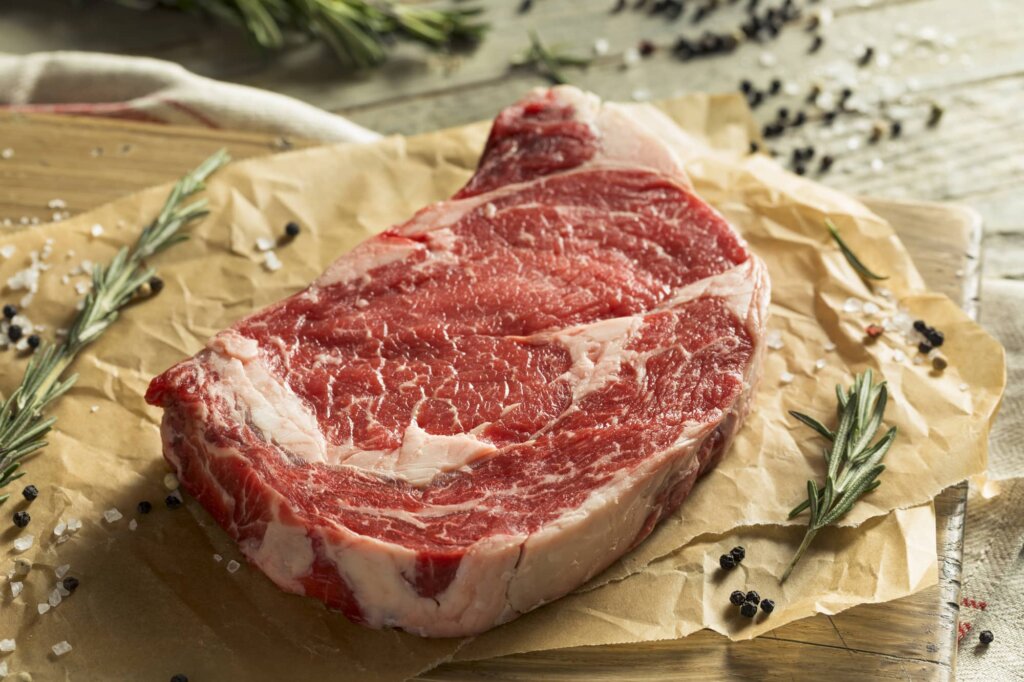
There’s a reason thicker steaks get all the praise: They’re simply the better choice compared to thin steaks in most cases. Steak thickness makes all the difference in your final results. Learn why investing in thick-cut steaks is more likely to give you the high-quality results you want, and learn how to cook thick steaks successfully.
Thin Cut Steak vs. Thick Cut Steak
Thickness can make more of a difference in steak than you might realize, especially when it comes to flavor and texture. Think about the last time you got a steak at a restaurant. Was it thin or thick cut? The answer is most likely a thick cut. That’s because thick-cut steaks offer more control over the cooking process. You can get a nice sear and still have a juicy pink interior.
But with thinner cuts, it’s difficult not to overcook them. And if you ever had an overcooked steak, you know it’s not usually a pleasant experience. Thin-cut steaks can become chewy and dry. On the other hand, thick steaks allow for techniques like reverse searing and dual-zone grilling, giving you the crispy brown finish and tender interior you look for in steak.
To be fair, there is some room for thin steaks. For example, thinner cuts like flank or skirt steak are great for dishes using thin strips of steak, like fajitas or steak salads. But if you’re eating steak on its own, thicker cuts are the way to go.
The Two Best Methods for Cooking a Thick Steak
Reverse searing and sous vide are two proven techniques for cooking a thick steak thoroughly.
Reverse Sear
A reverse sear requires you to cook the steak first and sear it after. For thick cuts, this method helps the steak cook internally without getting overcooked on the outside. To do it, you’ll cook the steak at low heat — usually in the oven, but grilling works, too — and finish it off with a sear in a hot skillet or on the grill.
Sous Vide
With sous vide, you’ll vacuum seal your steak and cook it in a controlled-temperature water bath to cook the steak uniformly. Then, after patting it dry, you can finish the steak off with a sear. This is an ideal method for taking the guesswork out of getting your steak to the proper temperature.
Top Tips for Cooking a Thick Steak Successfully
Here’s what you need to know about cooking a thick steak correctly every time:
- Bring to Room Temperature: Remove your steak from the fridge 30-45 minutes before cooking to help it cook evenly from the outside to the center.
- Season Before Cooking: Using a generous amount of salt and pepper to season your steak before cooking helps the steak form a crispier crust when searing.
- Preheat Your Cooking Surface: Whether you’re using a grill or a cast-iron skillet, preheat the cooking surface to high heat (around 500°F) to create a strong sear.
- Sear for a Flavorful Crust: Sear the steak for 2-3 minutes per side to develop a rich, caramelized exterior before moving it to indirect heat to finish cooking through.
- Allow to Rest: Let the steak rest for 5-10 minutes after cooking at room temperature. This gives the steak time to redistribute its juices throughout the meat for more tender bites.
Determining Doneness on a Steak
Judging the interior doneness can be a bit more difficult with a thick steak than a thin steak. But if you’re going for a specific level of doneness — or just want to make sure your steak isn’t undercooked — it’s an important step.
While some people check the doneness level by touching the steak to feel how much bounce-back it has, this method isn’t accurate. Steak cuts can feel different to the touch because some are simply more tender than others.
The best way to check steak doneness is by using a meat thermometer.
Test Doneness by Using a Steak Thermometer
A digital meat thermometer makes it easy to check the temperature of your steak accurately. Insert the probe into the thickest part of the steak and let it sit for several seconds until the temperature reading stops rising. A medium-rare steak is done cooking at 125-130°F. After it rests at room temperature for a few minutes, it should reach its final temperature of 130-135°F.
Steak Doneness Guide
| Doneness | Remove from Heat At | Final Temperature | Appearance | Texture |
|---|---|---|---|---|
| Rare | 115-120°F (46-49°C) | 120-130°F (49-54°C) | Cool, red center | Very soft & tender |
| Medium Rare | 125-130°F (52-54°C) | 130-135°F (54-57°C) | Warm, red center | Tender & juicy |
| Medium | 130-140°F (54-60°C) | 135-145°F (57-63°C) | Warm, pink center | Slightly firm but still juicy |
| Medium Well | 140-150°F (60-66°C) | 145-155°F (63-68°C) | Slightly pink center | Firm with little juice |
| Well Done | 150°F+ (66°C+) | 155°F+ (68°C+) | No pink, fully cooked | Firm & dry |
*Remove steak 5-10°F before target temp—it will continue to cook while resting.
Conclusion: How to Cook a Thick Steak
Mastering how to cook a thick steak is now within reach with this guide and helpful tips. Reverse searing and sous vide each deliver tasty results without leaving you with an undercooked or overcooked steak. For more guidance on cooking your favorite steaks, bookmark Steak University.

